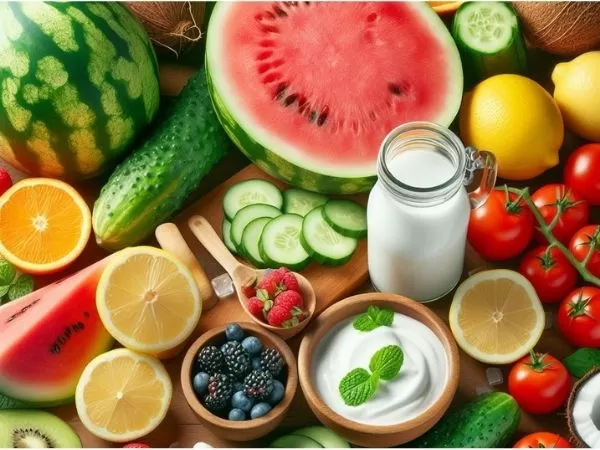The scorching summer sun puts you at risk for heat stroke, a condition in which your body overheats and causesserioussymptoms. If left untreated, heat stroke can haveserious consequences, ranging from dehydration and fatigue to organ failure and even death.
Fortunately, nature provides us witha variety ofdelicious and hydrating foods that protect us from the dangers of heat stroke. We will explore these foods and learn how they keep uscooland refreshed during the hot summer months.

Understanding Heatstroke
Heat strokeis a condition that occurs when the body’s thermoregulatory system is overwhelmed by external heat.Thisusuallyoccurswhen exposed to high temperatures for long periods.
Especially when combined with high humidity. When your body overheats, it can’t cool down effectively. In turn, your body temperature rises rapidly.
Symptoms of heatstrokevary,but often include the following:
- Throbbing headache
- Dizziness and light-headedness
- Increased heart rate
- Nausea and vomiting
- Warm, dry, or profuse sweating of the skin
- Confusion or disorientation
- Loss of consciousness
Heat stroke is an emergency that requires immediate treatment. If left untreated, it can cause serious complications such as brain damage, organ failure, and even death.
Preventing Heat Stroke with Food
One of the most effective ways to prevent heatstroke is by staying hydrated and consumingfoodsthat help regulate body temperature. Here are the top 10 foods that can help protect you from heatstroke:
1. Watermelon:

- Nutrients: Watermelonis packedwithwater content, electrolytes, and vitamins A and C.
- Benefits: It helps hydrate the body, replenish electrolytes lost through sweat, and provides antioxidant protection.
- Recipe: Enjoy watermelon sliceson their ownor blend them into a refreshing smoothie.
- Who should not eat: Individuals with diabetes should consume watermelon in moderation due to its natural sugar content.
2. Cucumber:

- Nutrients: Cucumbers are high in water, vitamins K and C, and potassium.
- Benefits: They hydrate the body, promote detoxification, and help lower body temperature.
- Recipe: Add sliced cucumbers tosalads,andsandwiches, or infuse them in water for a refreshing drink.
- Who should not eat: People with certain kidney conditions may need to limit their cucumber intake due to its potassium content.
3. Coconut Water:

- Nutrients: Coconut water is rich inelectrolytes, especially potassium.
- Benefits: It helps replenish electrolytes lost through sweating and keeps the body hydrated.
- Recipe: Drink coconut water straight from the coconut or purchase it in cartons from the store.
- Who should not drink: Those with nut allergies should avoid coconut water.
4. Mint:

- Nutrients: Mint contains vitamins A and C, as well asmenthol.
- Benefits: It has a cooling effect on the body, aids digestion, and freshens breath.
- Recipe: Add fresh mint leaves to salads,andsmoothies, or brew them into a refreshing tea.
- Who should not consume: Mint may aggravate symptoms of acid reflux in some individuals.
5. Yogurt:

- Nutrients: Yogurt is rich in probiotics, protein, calcium, andBvitamins.
- Benefits: It helps maintain gut health, replenish electrolytes, and cool the body.
- Recipe: Enjoy yogurton its own, or mix it with fruit for a nutritious parfait.
- Who should not eat: People with lactose intolerance or dairy allergies should opt for lactose-free yogurt or non-dairy alternatives.
6. Lemon:

- Nutrients: Lemons are high in vitamin C and citric acid.
- Benefits: They help alkalize the body, aid digestion, and promote hydration.
- Recipe: Squeeze lemon juice into water or use it as a dressing for salads and seafood dishes.
- Who should not consume: Individuals with citrus allergies should avoid lemons.
7. Tomatoes:

- Nutrients: Tomatoes are rich in vitamins A, C, and K, as well as lycopene.
- Benefits: They hydrate the body, provide antioxidant protection, and support skin health.
- Recipe: Enjoy tomatoes fresh in salads, sandwiches, or as a base for sauces and soups.
- Who should not eat: Some people may experience acid reflux or digestive discomfort from consuming tomatoes.
8. Green Leafy Vegetables:

- Nutrients: Green leafy vegetables like spinach, kale, and lettuce are rich in vitamins A, C, and K, as well as iron and calcium.
- Benefits: They hydrate the body, provide essential nutrients, and support overall health.
- Recipe: Use green leafy vegetables as a base for salads,andwraps, or blend them into smoothies.
- Who should not eat: Individuals taking blood-thinning medications should consume green leafy vegetables in moderation due to their vitamin K content.
9. Oranges:

- Nutrients: Oranges are high in vitamin C, fiber, and antioxidants.
- Benefits: They hydrate the body, boost immune function, and support cardiovascular health.
- Recipe: Enjoy oranges as a snack or squeeze fresh orange juice for a refreshing beverage.
- Who should not eat: People with citrus allergies should avoid oranges.
10. Berries:

- Nutrients: Berries such asstrawberries, blueberries, and raspberries are rich in vitamins, antioxidants, and fiber.
- Benefits: They hydrate the body, protect against oxidative stress, and support brain health.
- Recipe: Add berries to breakfast cereals,andyogurt, or blend them into smoothies.
- Who should not eat: Individuals with berry allergies should avoid consuming them.
FAQs:
1. Can I prevent heatstroke by drinking only water?
2. Are there any foods I should avoid during hot weather?
3. How much water should I drink to prevent heatstroke?
4. Can children and older adults also benefit from these foods?
5. Are there any warning signs of impending heatstroke?
Sum up,
Insummerit isvery importantto protect yourself from heat stroke. Alongside staying hydrated with water,incorporatinghydrating foods rich in electrolytes and nutrients. They can provide an extra layer of defense.Watermelon, cucumber, coconut water, mint, yogurt, lemon, tomatoes, green leafy vegetables, oranges, and berries.
These are just a few examples of foods that can help keep you cool, refreshed, and resilient againstthe dangers ofheatstroke.By makingthese foods a part of your summer diet, you canenjoy the season safely and comfortably.







